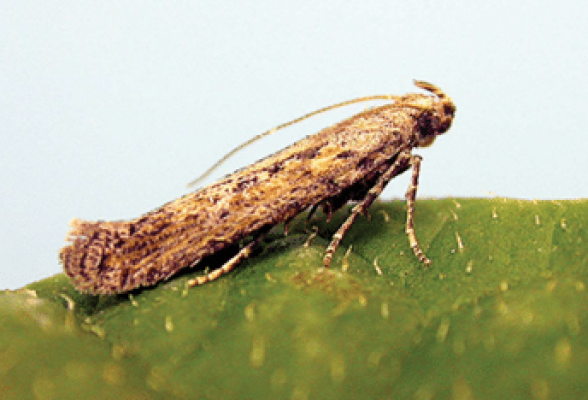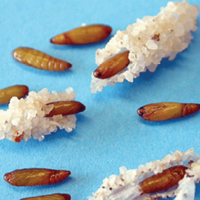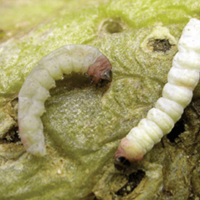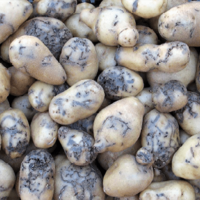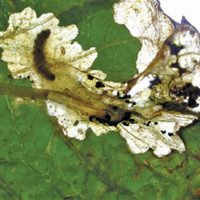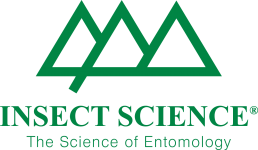Host plants
Larval hosts of the potato tuber moth include solanaceous plants such as potato (its main host), tomato, brinjal, tobacco, Cape gooseberry and various weeds.
Damage
Larvae are miners that make blotch leaf mines in leaves and stems and can cause severe yield loss when tubers are attacked, as illustrated. If moth numbers are very high early in the season, very young or small plants may be adversely affected by mining larvae. At the end of the season, when foliage starts to die naturally, some larvae move down through minute cracks in the ground and attack the tubers. The larvae tunnel just below the potato skin, causing distinct mines, but sometimes deeper mining also occurs. Tubers in storage are attacked by the larvae from eggs laid by moths that fly in from outside or by larvae in infested tubers bought in for storage. Depending on the severity of the initial infestation in stored tubers, the contents of an entire potato store can be destroyed within two months by the progeny of the emerging moths. The potato tuber moth is the most destructive pest on potato in southern Africa, especially when conditions are hot and dry.
Potato tuber moths are dormant during the day, hiding in the lower foliage. They are at their most active two hours after sunset. Male moths find females by tracing pheromone plumes, after which mating takes place almost immediately and most eggs are laid within 2-3 days. One female lays an average of 100-200 eggs, singly on plants or on the soil near plants. Eggs hatch within a week in the warmer months. Moths live for approximately one week and do not feed. They do, however, survive a few days longer if they have access to water or honeydew.
The larva usually remains within the plant while feeding and goes through four instars which last about two weeks. When mature, the larva exits it feeding site (leaf, stem, growth point or tuber) to pupate at ground level, moving either upwards or downwards depending on where it was feeding.
Pupation occurs on the soil within a tough cocoon, constructed a mixture of silk and soil. Sometimes, in stored potatoes, cocoons are constructed between adjacent tubers, but they are mostly found on the ground. In the summer, adult moths emerge after one week.
The total development time of the potato tuber moth is approximately four weeks in summer, but can last months during colder conditions. Tuber moth populations always overlap and no distinct peaks occur. No overwintering period occurs; moths emerge continually throughout the year, even during winter (Visser & Schoeman, 2004).
Natural enemies
Two parasitic wasps of South American origin, Copidosoma koehleri Blanchard, an egg-larval encyrtid parasitoid, and the braconid larval parasitoid Apanteles subandinus Blanchard, are responsible for potato tuber moth mortality in fields. These, and two other species which failed to establish, were imported to South Africa from various countries between 1963 and 1968. Several indigenous braconid and ichneumonid parasitoids have been reported attacking potato tuber moth larvae, but they have been replaced by the two important species in most areas. A detailed account of the initial biological control campaign against tuber moth in South Africa is given by Annecke & Moran (1982).
Effective predators include potter wasps (Vespidae) of the genus Synagris that remove tuber moth larvae from their leaf mines and mirid bugs and ants that feed on tuber moth eggs.
A naturally occurring granulose virus is known to kill potato tuber moth larvae under favourable conditions, when both ambient temperature and humidity are high. The virus occurs worldwide and augmentation release in other countries has resulted in limited success.
Management
Insecticide application is currently the most widely used and effective control strategy against the potato tuber moth. However, under certain environmental conditions that favour high reproduction rates, such as severe drought with accompanying high temperatures, insecticides do not effectively control potato tuber moth.
Ridging safeguards tubers from exposure and avoid cracks forming in the soil while tuber bulking is taking place. Potato tuber moth larvae cannot reach tubers which are covered with a soil layer of more than 50 mm, although infestation can take place via minute cracks in the ground that leads to the tubers. Frequent rain or irrigation helps to combat this.
Sanitation, aimed at reducing moth numbers during the off-season when potato plants in cultivated fields are not accessible to the pest, plays an important role. This involves the removal of piles of culled potatoes and regular destruction of volunteer potato plant and solanaceous weed hosts.
The above-mentioned parasitoids can reduce tuber moth numbers in fields by 98%. However, a high incidence of parasitism is not always related to low levels of damage, and parasitoids are not always present in fields.
Synthetic pheromones are available to monitor moths in fields and in storage but they are not an effective control method, as only males are trapped.

